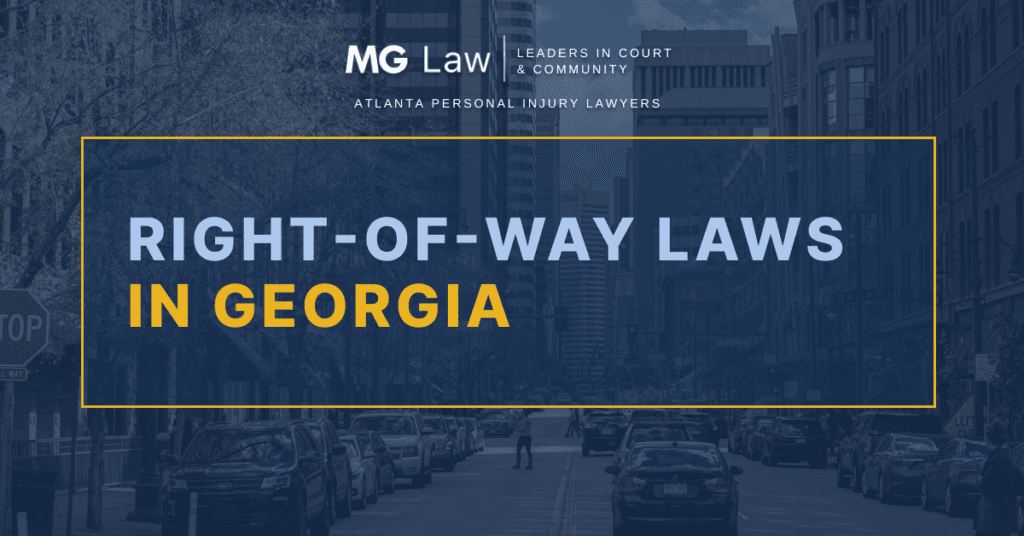
Traffic laws ensure the orderly movement of traffic across roadways and highways. Without these laws, the roads would be a free-for-all and the number of car accidents would skyrocket.
To obtain a license, applicants must demonstrate their knowledge of these rules by passing a written test.
Unfortunately, many people quickly forget what they learn in driver’s ed. And right of way laws seem to be one of the earliest pieces of information to go.
Without proper observance of these laws, many people will be injured in crashes that were entirely avoidable.
For a free consultation with an experienced car accident lawyer, please call (770) 988-5252 or fill out our online form today.
What Do We Mean By “Right of Way”?
This phrase refers to the lawful authority to enter a road or change lanes. When a person has the right of way, they have legal permission to make their move. By necessity, other vehicles must stop. If they don’t, then an accident can occur.
Georgia right of way laws come to matter in many accidents because some driver or pedestrian did not stop when they were supposed to. When a motorist refuses to stop, they can be held legally liable for the accident.
Some people wrongly assume that if Car A strikes Car B, then Car A is always at fault. In reality, we need to look at who had the right of way. It might be that Car B had the legal authority to move, though they were the one hit.
Right Of Way At Intersections
Who has the right to pass through an intersection first is a critical issue. When there are lights, the lights will tell you when it is lawful to go.
Without lights, however, there are some common rules motorists must follow:
- At a four-way intersection with stop signs for all drivers, every driver must stop. All drivers must yield the right of way to pedestrians. After that, the driver who is the first to arrive at the intersection can go first through the intersection.
- At some intersections, one driver will have a stop sign but the other does not. The driver facing a stop sign must stop and yield to pedestrians or vehicles in the intersection or about to enter the intersection.
- Two vehicles might arrive at an intersection with no stop signs or other traffic signs. The vehicle that arrives first can pass through the intersection. If both arrive at the same time, the vehicle on the left yields to the driver on the right.
- If you are making a left-hand turn at an intersection, yield to all oncoming traffic.
Always remember to drive safely as you make a turn. Having the right of way is not a license to speed or take other risky action. If you do, you can be negligent and at fault for the crash. In Georgia, drivers are allowed to make a right turn on red after coming to a complete stop and ensuring the way is clear, unless a sign at the intersection specifically prohibits it.
Some motorists might ignore the right of way rules listed above and proceed through the intersection before their turn. Even if you have the right of way, you should stop so that you do not cause a crash. Failure to stop (if you can) might make you partially to blame for the accident.
Merging With Traffic

Right of way rules can crop up when a vehicle tries to merge with other traffic.
This is always a dicey situation fraught with danger.
We see accidents involving merging on the highway when vehicles are traveling at top speed. Accidents can be deadly.
Remember the following rules:
- If you are merging into traffic, adjust your speed so you can merge into the lane safely. This might mean slowing down or speeding up.
- If you are in the lane and another lane is merging with yours, you should change lanes to free up space, if you can. This means switching into the left-hand lane.
- When you enter a highway from an alley or other road, you need to stop and yield to all vehicles traveling on the road as well as pedestrians who are crossing. These rules also apply if you are crossing the highway.
It is critical to drive as safely as possible when merging. Most highways have yield signs, which means you must slow down as you approach. In some situations, you might also need to stop—even if that makes it hard to merge.
Emergency Vehicles & School Buses
Certain vehicles have a right of way because of safety concerns or because they need to get to their destination in a timely manner.
Ambulances and other emergency vehicles are some obvious examples. If they are using their emergency lights, you must move to the shoulder of the road. If there is no shoulder, then move as far to the right as you can before stopping. Motorists must use caution so they do not endanger or strike other motorists, pedestrians, cyclists, or others.
If you must pull over at an intersection, don’t stop in such a way that you block the intersection.
With school buses, the driver should use flashing yellow lights when preparing to stop. Any driver must slow down and prepare to stop as soon as they see the yellow. When the bus lights turn red, you must stop. It is a criminal violation to pass a school bus with red lights and its stop sign extended. Even when a bus has its yellow lights on, however, motorists absolutely must watch for children scooting into the road.
Right and Left Turns on a Red Light in Georgia
Georgia law enforces that drivers must come to a complete stop at stop signs, meaning the vehicle’s wheels must completely cease rolling. Failure to comply may result in a traffic citation for failure to stop.
To help with the efficient flow of traffic, Georgia law allows motorists to make turns on a red light in certain situations:
- You can make a right-on-red turn provided no sign at the intersection prohibits it. You must come to a complete stop and yield to traffic and pedestrians. You can only make the turn if you determine it is safe to do so.
- You can also make a left-on-red turn if there is no sign prohibiting it and you are turning from the left lane of a one-way street into a one-way street (and going the proper direction). You must come to a complete stop and yield to traffic and pedestrians. You can only make the turn if safe to do so.
Unfortunately, many drivers do not stop but “roll through” the intersection. Rolling stops are not allowed in Georgia. Come to a complete stop and check that the way is clear. You could hurt someone if you don’t.
Injured in a Georgia Auto Accident? Contact Us
MG Law has the experience you need following an accident. Give us a call at (770) 988-5252 or send an online message today to schedule a free consultation.


